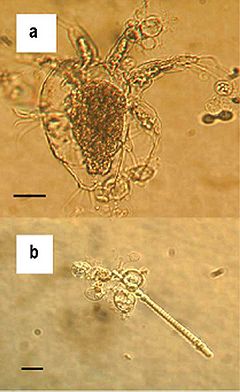Rhizophydiales
| Rhizophydiales | ||||||||||||
|---|---|---|---|---|---|---|---|---|---|---|---|---|
 Зооспорангія Batrachochytrium dendrobatidis, що росте на прісноводних членистоногих (a) та водоростях (b). Масштабна лінія показує 30 µm.
| ||||||||||||
| Біологічна класифікація | ||||||||||||
| ||||||||||||
| Rhizophydium globosum Schenk 1858 | ||||||||||||
Роди
| ||||||||||||
|
дивитись текст | ||||||||||||
Посилання
| ||||||||||||
|
Rhizophydiales — порядок хитрідіомікотових грибів класу Хитрідіоміцети (Chytridiomycetes). Представники ряду живуть в основному у ґрунті, а також у морі та прісних водоймах, де виконують функції паразитів та редуцентів. Це в основному паразити безхребетних, водоростей та інших грибів. Відомо два види роду Batrachochytrium, що паразитують на земноводних. Вид Rhizophydium graminis є паразитом пшениці, але великої шкоди їй не приносить.
Rhizophydiales містить наступні роди:
- Rhizophydium Schenk 1858
- Kappamyces Letcher & M.J. Powell 2005[2]
- Terramyces Letcher 2006[1]
- Boothiomyces Letcher 2006
- Alphamyces Letcher 2008[3]
- Betamyces Letcher 2012[4]
- Gammamyces Letcher 2012
- Angulomyces Letcher 2008
- Aquamyces Letcher 2008
- Globomyces Letcher 2008
- Urceomyces Letcher 2008
- Gorgonomyces Letcher 2008
- Pateramyces Letcher 2008
- Protrudomyces Letcher 2008
- Coralloidiomyces Letcher 2008[5]
- Operculomyces M.J.Powell, Letcher & Longcore 2011[6]
- Batrachochytrium Longcore, Pessier & D.K. Nichols 1999[7] (no clear relatives)[8]
- Homolaphlyctis Longcore, Letcher & T.Y. James 2011 [9]
У 2008 році було запропоновано створити наступні родини:
- Alphamycetaceae: Alphamyces, Betamyces,Gammamyces
- Angulomycetaceae: Angulomyces
- Aquamycetaceae: Aquamyces
- Globomycetaceae: Globomyces, Urceomyces
- Gorgonomycetaceae: Gorgonomyces
- Kappamycetaceae: Kappamyces
- Pateramycetaceae: Pateramyces
- Protrudomycetaceae: Protrudomyces
- Rhizophydiaceae: Rhizophydium
- Terramycetaceae: Boothiomyces, Terramyces
- Incerta sedis: Batrachochytrium, Coralloidiomyces, Operculomyces, Homolaphlyctis
- ↑ а б Letcher, P.M.; Powell, MJ; Churchill, PF; Chambers, JG (2006). Ultrastructural and molecular phylogenetic delineation of a new order, the Rhizophydiales (Chytridiomycota). Mycol. Res. 110 (Pt 8): 898—915. doi:10.1016/j.mycres.2006.06.011. PMID 16919432.
- ↑ Letcher, P.M.; Powell, MJ (2005). Kappamyces, a new genus in the Chytridiales (Chytridiomycota). Nova Hedwigia. 80: 113—133.
- ↑ Letcher, P.M.; Vélez, CG; Barrantes, ME; Powell, MJ; Churchill, PF; Wakefield, WS (2008). Ultrastructural and molecular analyses of Rhizophydiales (Chytridiomycota) isolates from North America and Argentina. Mycol. Res. 112 (Pt 7): 759—782. doi:10.1016/j.mycres.2008.01.025. PMID 18501579.
- ↑ Letcher, P.M.; Vélez, CG; Schultz, S; Powell, MJ (2012). New taxa are delineated in Alphamycetaceae (Rhizophydiales, Chytridiomycota). Nova Hedwigia. 94 (Pt 1-2): 9—29. doi:10.1127/0029-5035/2012/0094-0009.
- ↑ Letcher, P.M.; Powell, MJ; Viusent, MC (2008). Rediscovery of an unusual chytridiaceous fungus new to the order Rhizophydiales. Mycologia. 100 (2): 325—334. doi:10.3852/mycologia.100.2.325. PMID 18592907.
- ↑ Powell, M.J.; Letcher, PM; Longcore, JE (2011). Operculomyces is a new genus in the order Rhizophydiales. Mycologia. 103 (4): 854—862. doi:10.3852/10-293. PMID 21262983.
- ↑ Longcore, J.E..; Pessier, A.P.; Nichols, D.K (1999). Batrachochytrium dendrobatidis gen. et sp. nov., a chytrid pathogenic to amphibians. Mycologia. 91 (2): 219—227. doi:10.2307/3761366.
- ↑ Hibbett, D.S. та ін. (March 2007). A higher level phylogenetic classification of the Fungi. Mycological Research. 111 (5): 509—547. doi:10.1016/j.mycres.2007.03.004. PMID 17572334.
{{cite journal}}: Явне використання «та ін.» у:|author=(довідка) - ↑ Longcore, J.E.; Letcher, P.M.; James, T.Y. (2011). Homolaphlyctis polyrhiza gen. et sp. nov., a species in the Rhizophydiales (Chytridiomycetes) with multiple rhizoidal axes. Mycotaxon. 118: 433—440.
| Це незавершена стаття з мікології. Ви можете допомогти проєкту, виправивши або дописавши її. |